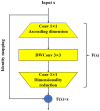Aluminum surface defect detection method based on a lightweight YOLOv4 network
- PMID: 37422570
- PMCID: PMC10329709
- DOI: 10.1038/s41598-023-38085-x
Aluminum surface defect detection method based on a lightweight YOLOv4 network
Abstract
Deep learning is currently being used to automate surface defect detection in aluminum. The common target detection models based on neural networks often have a large number of parameters and a slow detection speed, which is not conducive to real-time detection. Therefore, this paper proposes a lightweight aluminum surface defect detection model, M2-BL-YOLOv4, based on the YOLOv4 algorithm. First, in the YOLOv4 model, the complex CSPDarkNet53 backbone network was modified into an inverted residual structure, which greatly reduced the number of parameters in the model and increased the detection speed. Second, a new feature fusion network, BiFPN-Lite, is designed to improve the fusion ability of the network and further improve its detection accuracy. The final results show that the mean average precision of the improved lightweight YOLOv4 algorithm in the aluminum surface defect test set reaches 93.5%, the number of model parameters is reduced to 60% of the original, and the number of frames per second (FPS) detected is 52.99, which increases the detection speed by 30%. The efficient detection of aluminum surface defects is realized.
© 2023. The Author(s).
Conflict of interest statement
The authors declare no competing interests.
Figures









Similar articles
-
EBE-YOLOv4: A lightweight detecting model for pine cones in forest.Front Plant Sci. 2022 Nov 11;13:1042332. doi: 10.3389/fpls.2022.1042332. eCollection 2022. Front Plant Sci. 2022. PMID: 36438091 Free PMC article.
-
Research on Insulator Defect Detection Based on an Improved MobilenetV1-YOLOv4.Entropy (Basel). 2022 Nov 2;24(11):1588. doi: 10.3390/e24111588. Entropy (Basel). 2022. PMID: 36359678 Free PMC article.
-
Lightweight Helmet Detection Algorithm Using an Improved YOLOv4.Sensors (Basel). 2023 Jan 21;23(3):1256. doi: 10.3390/s23031256. Sensors (Basel). 2023. PMID: 36772297 Free PMC article.
-
A New Deep Model for Detecting Multiple Moving Targets in Real Traffic Scenarios: Machine Vision-Based Vehicles.Sensors (Basel). 2022 May 14;22(10):3742. doi: 10.3390/s22103742. Sensors (Basel). 2022. PMID: 35632150 Free PMC article.
-
A Study on Railway Surface Defects Detection Based on Machine Vision.Entropy (Basel). 2021 Oct 30;23(11):1437. doi: 10.3390/e23111437. Entropy (Basel). 2021. PMID: 34828135 Free PMC article.
Cited by
-
Hyperbolic geometry enhanced feature filtering network for industrial anomaly detection.Sci Rep. 2025 Jul 15;15(1):25668. doi: 10.1038/s41598-025-07550-0. Sci Rep. 2025. PMID: 40665106 Free PMC article.
-
Multi-defect detection and classification for aluminum alloys with enhanced YOLOv8.PLoS One. 2025 Mar 20;20(3):e0316817. doi: 10.1371/journal.pone.0316817. eCollection 2025. PLoS One. 2025. PMID: 40111987 Free PMC article.
-
RJ-TinyViT: an efficient vision transformer for red jujube defect classification.Sci Rep. 2024 Nov 13;14(1):27776. doi: 10.1038/s41598-024-77333-6. Sci Rep. 2024. PMID: 39537645 Free PMC article.
-
An algorithm for power transmission line fault detection based on improved YOLOv4 model.Sci Rep. 2024 Feb 29;14(1):5046. doi: 10.1038/s41598-024-55768-1. Sci Rep. 2024. PMID: 38424258 Free PMC article.
References
-
- Deng Y, Zhang X. Development of aluminium and aluminium alloy. Chin. J. Nonferrous Met. 2019;29:2115–2141.
-
- Zhang J, Kang X, Ni H, Ren F. Surface defect detection of steel strips based on classification priority YOLOv3-dense network. Ironmak. Steelmak. 2020;48:547–558. doi: 10.1080/03019233.2020.1816806. - DOI
-
- Liu R, Huang M, Gao Z, Cao Z, Cao P. MSC-DNet: An efficient detector with multi-scale context for defect detection on strip steel surface. Measurement. 2023;209:112467–112467. doi: 10.1016/j.measurement.2023.112467. - DOI
-
- Xu Z, Huang D. Defect detection on aluminum surfaces based on deep learning. J. East China Norm. Univ. 2020;2020:105–114.
MeSH terms
Substances
Grants and funding
LinkOut - more resources
Full Text Sources
Miscellaneous

